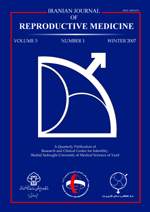
|
International Journal of Reproductive BioMedicine
Research and Clinical Center for Infertility, Shahid Sadoughi University of Medical Sciences of Yazd
ISSN: 1680-6433
EISSN: 1680-6433
Vol. 10, No. 1, 2012, pp. 7-14
|
 Bioline Code: rm12002
Bioline Code: rm12002
Full paper language: English
Document type: Research Article
Document available free of charge
|
|
|
International Journal of Reproductive BioMedicine, Vol. 10, No. 1, 2012, pp. 7-14
| en |
Long-term effects of maternal exposure to Di (2-ethylhexyl) Phthalate on sperm and testicular parameters in Wistar rats offspring
Dorostghoal, Mehran; Moazedi, Ahmad Ali; Zardkaf, Adel &
Abstract
Background: Phthalate esters have been shown to cause reproductive toxicity in both developing and adult animals.
Objective: This study was designed to assess long-term effects of maternal exposure to Di (2-ethylhexyl) Phthalate (DEHP) on reproductive ability of both neonatal and adult male offspring.
Materials and Methods: 60 female rats randomly divided in four equal groups; vehicle control and three treatment groups that received 10, 100 and 500 mg/kg/day DEHP via gavage during gestation and lactation. At different ages after birth, the volumes of testes were measured by Cavellieri method, testes weights recorded and epididymal sperm samples were assessed for number and gross morphology of spermatozoa. Following tissue processing, seminiferous tubules diameter and germinal epithelium height evaluated with morphometric techniques.
Results: Mean testis weight decreased significantly (p <0.05) in 500 mg/kg/day dose group from 28 to 150 days after birth. Significant decreases were seen in total volumes of testis in 100 (p<0.05) and 500 (p<0.01) mg/kg/day doses groups until 150 days after birth. Seminiferous tubules diameter and germinal epithelium height decreased significantly in 100 (p<0.05) and 500 (p<0.01) mg/kg/day doses groups during postnatal development. Also, mean sperm density in 100 mg/kg/day (p<0.05) and 500 mg/kg/day (p<0.01) doses groups and percent of morphologically normal sperm in highest dose group (p<0.05) decreased significantly until 150 days after birth.
Conclusion: Present study showed that maternal exposure to Di (2-ethylhexyl) Phthalate during gestation and lactation caused to permanent and dose-related reductions of sperm and testicular parameters in rats offspring.
Keywords
Di (2-ethylhexyl) Phthalate, Testis, Sperm, Morphometry, Stereology.
|
| |
© Copyright 2012 - Iranian Journal of Reproductive Medicine
Alternative site location: http://www.ijrm.ir
|
|
